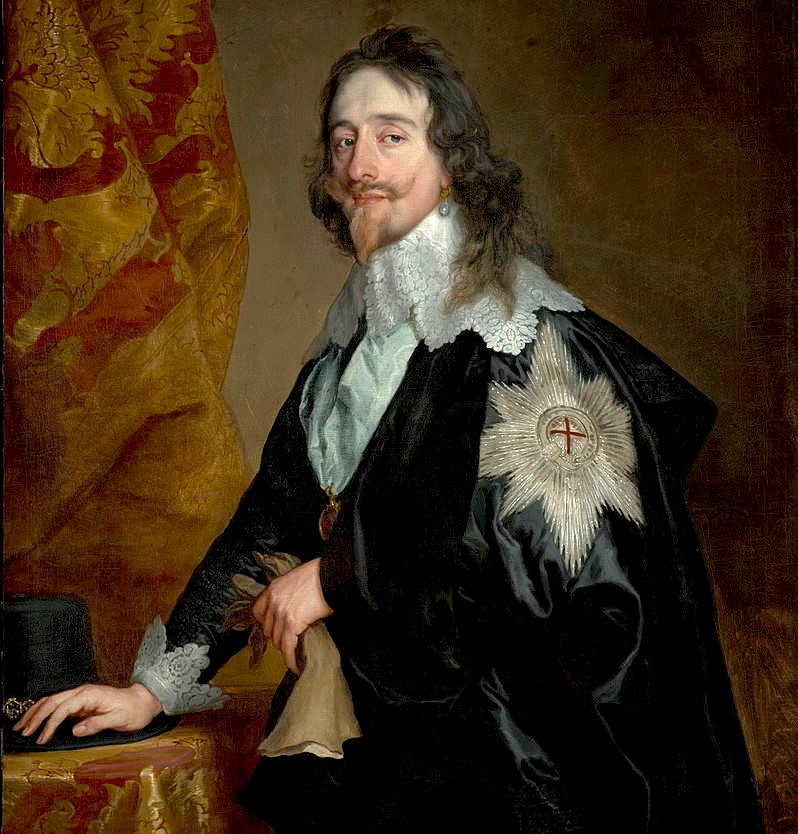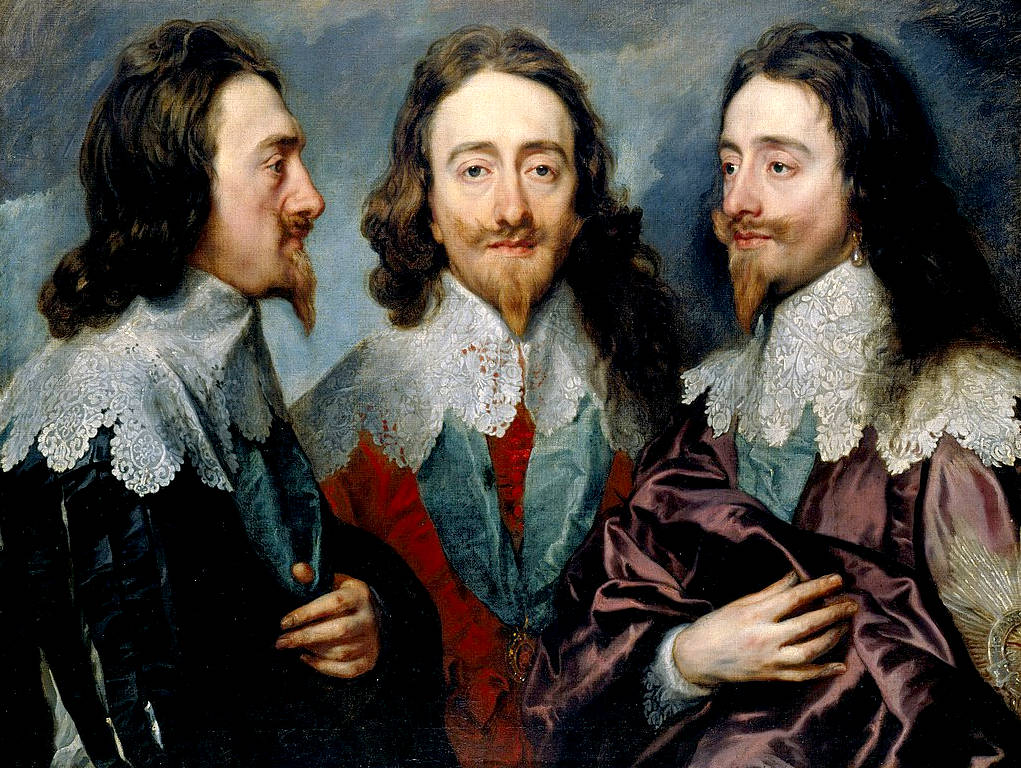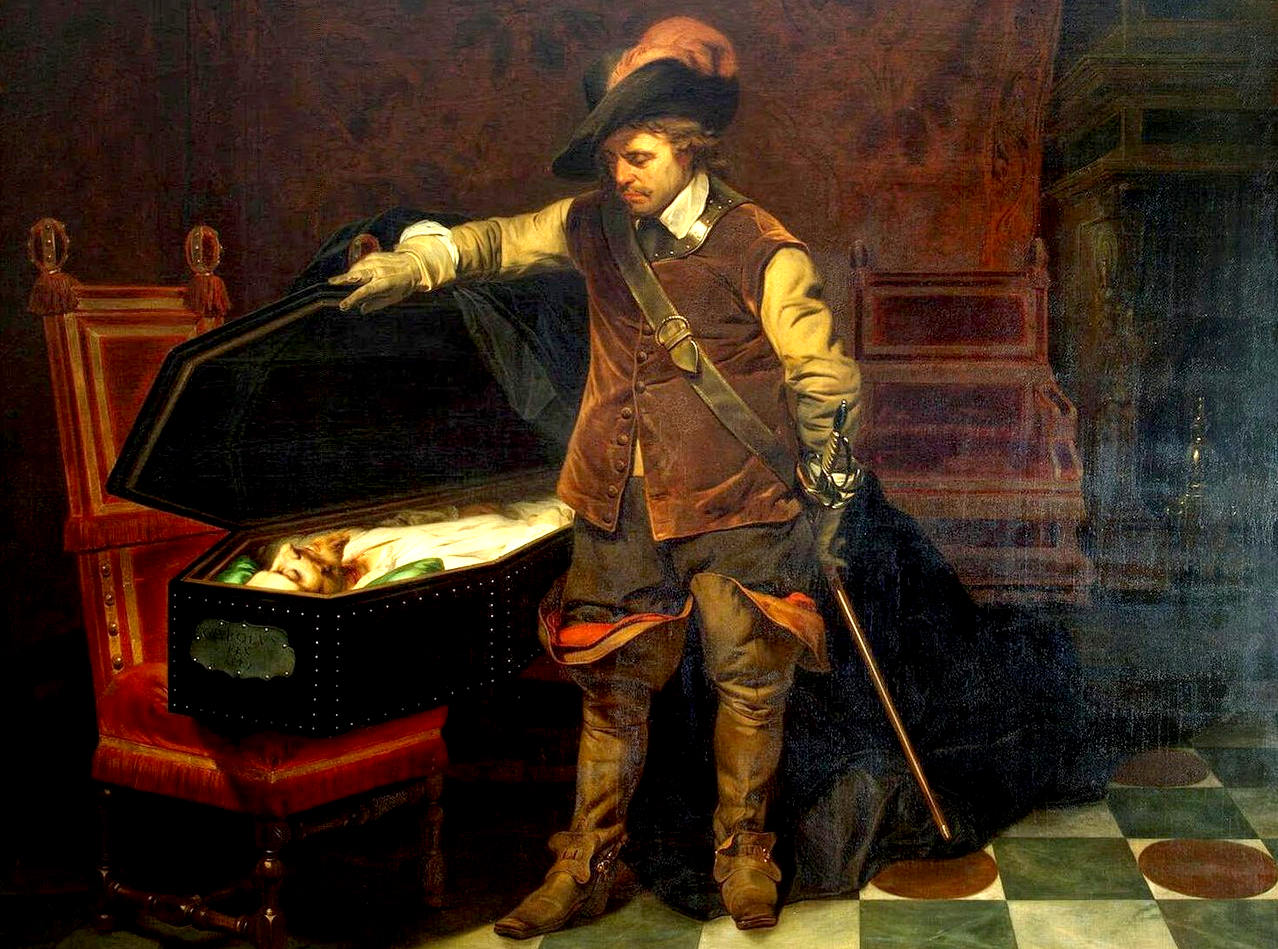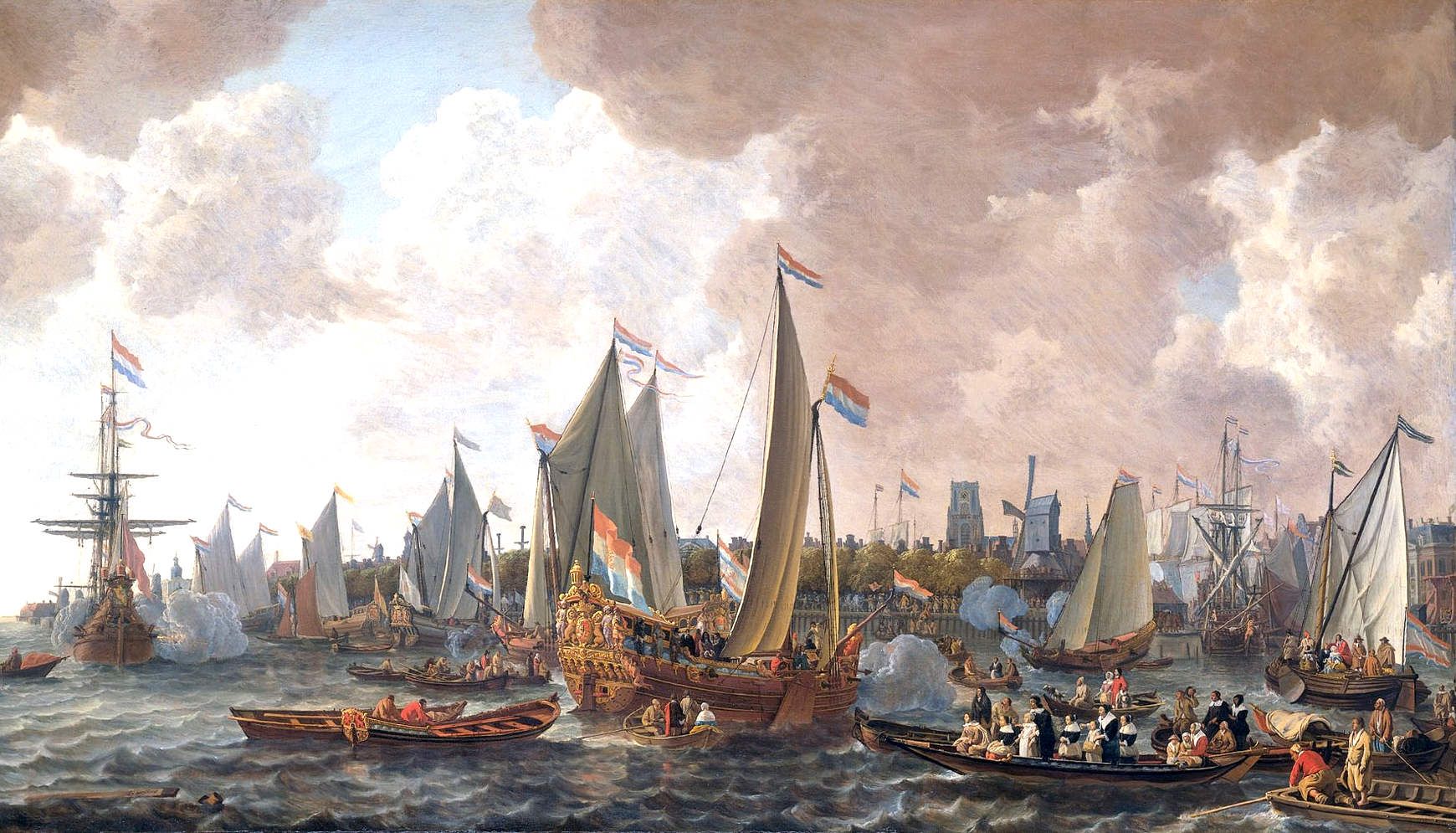|

Portrait
of King Charles I
Charles I (19 November 1600 – 30 January 1649) was King of England, Scotland, and Ireland from 27 March 1625 until his execution in 1649. He was born into the House of Stuart as the second son of King James VI of Scotland, but after his father inherited the English throne in 1603 (as James I), he moved to England, where he spent much of the rest of his life. He became heir apparent to the kingdoms of England, Scotland, and Ireland in 1612 upon the death of his elder brother, Henry Frederick, Prince of Wales. An unsuccessful and unpopular attempt to marry him to the Spanish Habsburg infanta Maria Anna culminated in an eight-month visit to Spain in 1623 that demonstrated the futility of the marriage negotiation. Two years later, he married the Bourbon princess Henrietta Maria of France.
After his succession in 1625, Charles quarrelled with the Parliament of England, which sought to curb his royal prerogative. He believed in the divine right of kings, and was determined to govern according to his own conscience. Many of his subjects opposed his policies, in particular the levying of taxes without parliamentary consent, and perceived his actions as those of a tyrannical absolute monarch. His religious policies, coupled with his marriage to a Roman Catholic, generated antipathy and mistrust from Reformed religious groups such as the English Puritans and Scottish Covenanters, who thought his views too Catholic. He supported high church Anglican ecclesiastics such as Richard Montagu and William Laud, and failed to aid continental Protestant forces successfully during the Thirty Years' War. His attempts to force the Church of Scotland to adopt high Anglican practices led to the Bishops' Wars, strengthened the position of the English and Scottish parliaments, and helped precipitate his own downfall.
From 1642, Charles fought the armies of the English and Scottish parliaments in the English Civil War. After his defeat in 1645 at the hands of the Parliamentarian New Model Army, he fled north from his base at Oxford. Charles surrendered to a Scottish force and after lengthy negotiations between the English and Scottish parliaments he was handed over to the Long Parliament in London. Charles refused to accept his captors' demands for a constitutional monarchy, and temporarily escaped captivity in November 1647. Re-imprisoned on the Isle of Wight, he forged an alliance with Scotland, but by the end of 1648, the New Model Army had consolidated its control over England. Charles was tried, convicted, and executed for high treason in January 1649. The monarchy was abolished and the Commonwealth of England was established as a republic. The monarchy was restored to Charles's son
Charles II in 1660.
ENGLISH CIVIL WARS
After a series of battles between the Cavaliers and Roundheads, there followed a series of defeats for the royalists, and then the siege of Oxford, from which Charles escaped (disguised as a servant) in April 1646. He put himself into the hands of the Scottish presbyterian army besieging Newark, and was taken northwards to Newcastle upon Tyne. After nine months of negotiations, the Scots finally arrived at an agreement with the English Parliament: in exchange for £100,000, and the promise of more money in the future, the Scots withdrew from Newcastle and delivered Charles to the parliamentary commissioners in January 1647.
Parliament held Charles under house arrest at Holdenby House in Northamptonshire until Cornet George Joyce took him by threat of force from Holdenby on 3 June in the name of the New Model Army.
From Carisbrooke, Charles continued to try to bargain with the various parties. In direct contrast to his previous conflict with the Scottish Kirk, on 26 December 1647 he signed a secret treaty with the Scots. Under the agreement, called the "Engagement", the Scots undertook to invade England on Charles's behalf and restore him to the throne on condition that presbyterianism be established in England for three years.
The royalists rose in May 1648, igniting the Second Civil War, and as agreed with Charles, the Scots invaded England. Uprisings in Kent, Essex, and Cumberland, and a rebellion in South Wales, were put down by the New Model Army, and with the defeat of the Scots at the Battle of Preston in August 1648, the royalists lost any chance of winning the war.
Charles's only recourse was to return to negotiations, which were held at Newport on the Isle of Wight. On 5 December 1648, Parliament voted 129 to 83 to continue negotiating with the king, but Oliver Cromwell and the army opposed any further talks with someone they viewed as a bloody tyrant and were already taking action to consolidate their power.

Portrait
of King Charles
TRIAL
Charles was moved to Hurst Castle at the end of 1648, and thereafter to Windsor Castle. In January 1649, the Rump House of Commons indicted him for treason; the House of Lords rejected the charge. The idea of trying a king was novel. The Chief Justices of the three common law courts of England—Henry Rolle, Oliver St John and John Wilde—all opposed the indictment as unlawful. The Rump Commons declared itself capable of legislating alone, passed a bill creating a separate court for Charles's trial, and declared the bill an act without the need for royal assent. The High Court of Justice established by the Act consisted of 135 commissioners, but many either refused to serve or chose to stay away. Only 68 (all firm Parliamentarians) attended Charles's trial on charges of high treason and "other high crimes" that began on 20 January 1649 in Westminster Hall. John Bradshaw acted as President of the Court, and the prosecution was led by Solicitor General John Cook.
Charles was accused of treason against England by using his power to pursue his personal interest rather than the good of the country. The charge stated that he, "for accomplishment of such his designs, and for the protecting of himself and his adherents in his and their wicked practices, to the same ends hath traitorously and maliciously levied war against the present Parliament, and the people therein represented", and that the "wicked designs, wars, and evil practices of him, the said Charles Stuart, have been, and are carried on for the advancement and upholding of a personal interest of will, power, and pretended prerogative to himself and his family, against the public interest, common right, liberty, justice, and peace of the people of this nation." Presaging the modern concept of command responsibility, the indictment held him "guilty of all the treasons, murders, rapines, burnings, spoils, desolations, damages and mischiefs to this nation, acted and committed in the said wars, or occasioned thereby." An estimated 300,000 people, or 6% of the population, died during the war.
Over the first three days of the trial, whenever Charles was asked to plead, he refused, stating his objection with the words: "I would know by what power I am called hither, by what lawful authority...?" He claimed that no court had jurisdiction over a monarch, that his own authority to rule had been given to him by God and by the traditional laws of England, and that the power wielded by those trying him was only that of force of arms. Charles insisted that the trial was illegal, explaining that,
"..no earthly power can justly call me (who am your King) in question as a delinquent ... this day's proceeding cannot be warranted by God's laws; for, on the contrary, the authority of obedience unto Kings is clearly warranted, and strictly commanded in both the Old and New Testament ... for the law of this land, I am no less confident, that no learned lawyer will affirm that an impeachment can lie against the King, they all going in his name: and one of their maxims is, that the King can do no wrong ... the higher House is totally excluded; and for the House of Commons, it is too well known that the major part of them are detained or deterred from sitting ... the arms I took up were only to defend the fundamental laws of this kingdom against those who have supposed my power hath totally changed the ancient government."
The court, by contrast, challenged the doctrine of sovereign immunity and proposed that "the King of England was not a person, but an office whose every occupant was entrusted with a limited power to govern 'by and according to the laws of the land and not otherwise'."
At the end of the third day, Charles was removed from the court, which then heard over 30 witnesses against him in his absence over the next two days, and on 26 January condemned him to death. The next day, the king was brought before a public session of the commission, declared guilty, and sentenced. Fifty-nine of the commissioners signed Charles's death
warrant.

EXECUTION
Charles's execution was scheduled for Tuesday, 30 January 1649. Two of his children remained in England under the control of the Parliamentarians: Elizabeth and Henry. They were permitted to visit him on 29 January, and he bade them a tearful farewell. The next morning, he called for two shirts to prevent the cold weather causing any noticeable shivers that the crowd could have mistaken for fear: "the season is so sharp as probably may make me shake, which some observers may imagine proceeds from fear. I would have no such imputation."
He walked under guard from St James's Palace, where he had been confined, to the Palace of Whitehall, where an execution scaffold had been erected in front of the Banqueting House. Charles was separated from spectators by large ranks of soldiers, and his last speech reached only those with him on the scaffold. He blamed his fate on his failure to prevent the execution of his loyal servant Strafford: "An unjust sentence that I suffered to take effect, is punished now by an unjust sentence on me." He declared that he had desired the liberty and freedom of the people as much as any, "but I must tell you that their liberty and freedom consists in having government ... It is not their having a share in the government; that is nothing appertaining unto them. A subject and a sovereign are clean different things." He continued, "I shall go from a corruptible to an incorruptible Crown, where no disturbance can be."
At about 2:00 p.m., Charles put his head on the block after saying a prayer and signalled the executioner when he was ready by stretching out his hands; he was then beheaded in one clean stroke. According to observer Philip Henry, a moan "as I never heard before and desire I may never hear again" rose from the assembled crowd, some of whom then dipped their handkerchiefs in the king's blood as a memento.
The executioner was masked and disguised, and there is debate over his identity. The commissioners approached Richard Brandon, the common hangman of London, but he refused, at least at first, despite being offered £200. It is possible he relented and undertook the commission after being threatened with death, but others have been named as potential candidates, including George Joyce, William Hulet and Hugh Peters. The clean strike, confirmed by an examination of the king's body at Windsor in 1813, suggests that the execution was carried out by an experienced headsman.
It was common practice for the severed head of a traitor to be held up and exhibited to the crowd with the words "Behold the head of a traitor!" Charles's
head was
exhibited, but those words were not used, possibly because the executioner did not want his voice recognised. On the day after the execution, the king's head was sewn back onto his body, which was then embalmed and placed in a lead coffin.
The commission refused to allow Charles's burial at Westminster Abbey, so his body was conveyed to Windsor on the night of 7 February. He was buried in private on 9 February 1649 in the
Henry VIII vault in the chapel's quire, alongside the coffins of
Henry VIII and Henry's third wife, Jane Seymour, in St George's Chapel, Windsor Castle. The king's son, Charles II, later planned for an elaborate
royal mausoleum to be erected in Hyde Park, London, but it was never built.
LEGACY
With the monarchy overthrown, England became a republic or "Commonwealth". The House of Lords was abolished by the Rump Commons, and executive power was assumed by a Council of State. All significant military opposition in Britain and Ireland was extinguished by the forces of Oliver Cromwell in the Third English Civil War and the Cromwellian conquest of Ireland. Cromwell forcibly disbanded the Rump Parliament in 1653, thereby establishing the Protectorate with himself as Lord Protector. Upon his death in 1658, he was briefly succeeded by his ineffective son, Richard. Parliament was reinstated, and the monarchy was restored to Charles I's eldest son, Charles II, in 1660.
In
2022, Charles III became king of England, on the death of Queen
Elizabeth,
at the age of 95 in 2022.

ABOUT
THE ROYALS
The Prince
of Wales, is currently the third King of England, named Charles
III; in
waiting. His
son, the Duke
of Cambridge, Prince
William, is also a King in waiting - as of 2022 as
William V.
Their mother and grandmother, respectively, Queen
Elizabeth II, was the British Monarch, who passed aged 95.
The previous King, Charles
II, ruled from 1630 until 1685, gave a Royal
Charter to export captured native Africans as slaves to British colonies.
Queen
Elizabeth I (Good Queen Bess), was famous for commissioning privateers
to carry out acts of piracy on the high seas, to boost the coffers of her
Treasury. As was Queen
Anne 1665 - 1714. King
George I carried on with privateers, then politics changed during his
reign 1714 to 1727.
|



